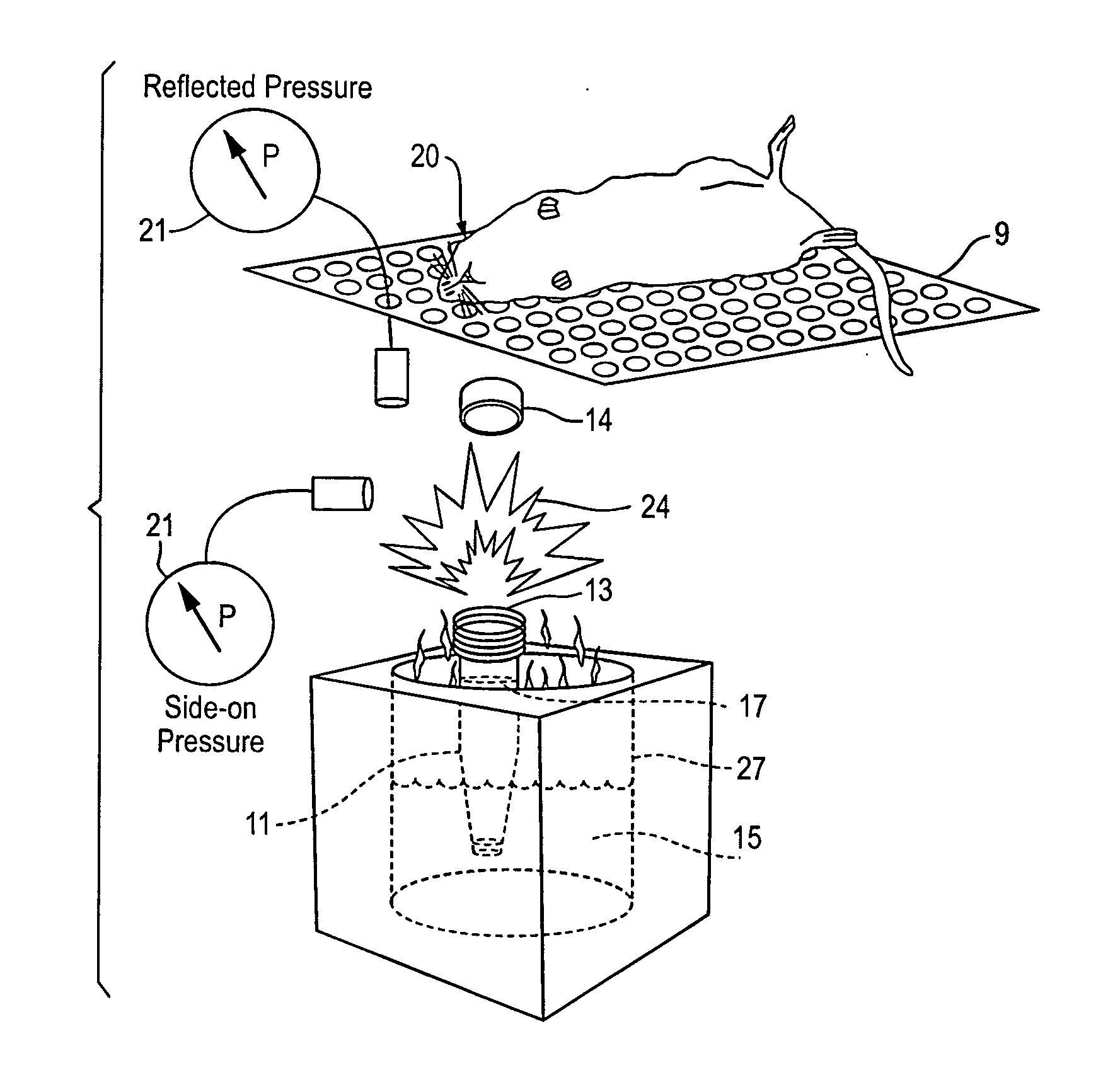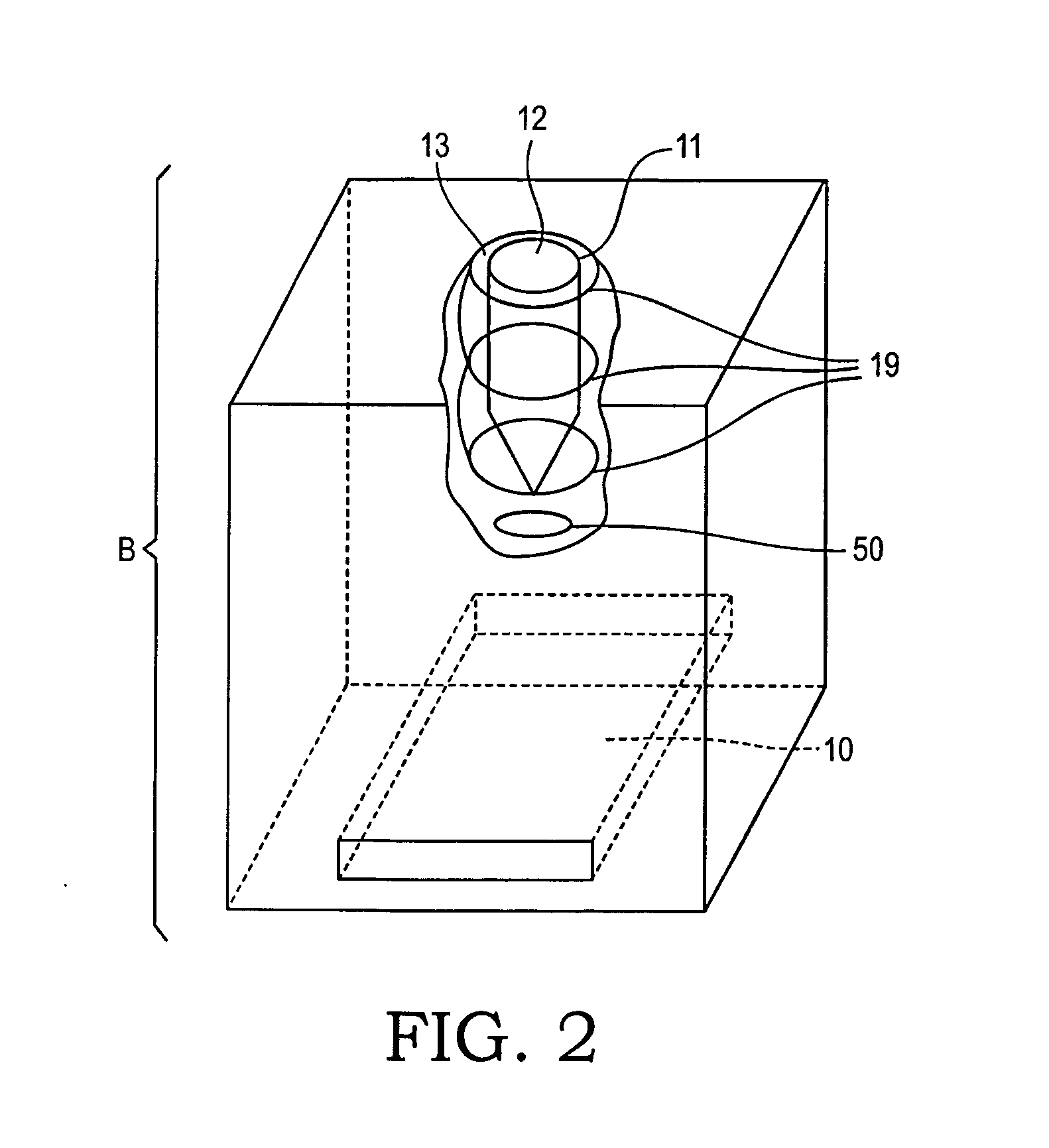Device and method for inducing brain injury in animal test subjects
a brain injury and animal test technology, applied in the field of animal test subjects inducing brain injury, can solve the problems of limited objective diagnostic tools and knowledge about what happens in the brain following this type of injury, increased risk of ptsd and/or neurodegenerative disorders, and difficult clinical diagnosis, so as to improve the control of the “pressure wave effect” and the effect of reducing the risk of brain injury
- Summary
- Abstract
- Description
- Claims
- Application Information
AI Technical Summary
Benefits of technology
Problems solved by technology
Method used
Image
Examples
example 1
Method for Inducing Projectile-Mediated Concussive Injury (Unprotected) with the First Embodiment
[0088]Anesthetized rats (with 2% isoflurane) were exposed to concussive impact via a cap or other projectile 14 targeted and propelled by compressed CO2 gas released from 1.7 g dry ice (FIGS. 1, 2, 4, 5 and 14). A cap 14 was tightly screwed on a microcentrifuge tube 11 using a torque meter and aimed at a target head 20. The targeted head mid-line site was 0.5-1 cm rostral to the interaural line. The tube 11 is heated to induce rapid CO2 sublimation of dry ice 17 and a resultant increase in gas pressure within the tube 11. The pressure builds up in the tube until the thread on the tube fails to hold the cap in place, thus the cap is launched as a projectile in an impact trajectory towards the targeted head 20. Using a high-speed camera (2800 frames / sec). The velocity of the projectile was 47.2±2.3 m / s as estimated based on high speed videos (3 kHz) and it was not related to the amount of ...
example 2
Method for Inducing Pressure Wave Concussive Injury the First Embodiment
[0090]Anesthetized rats (with 2% isoflurane) were exposed to concussive impact via a cap or other projectile 14 targeted and propelled by compressed CO2 gas released from 1.7 g dry ice (FIGS. 1, 2, 4, 5 and 14). A cap 14 was tightly screwed on a microcentrifuge tube 11 using a torque meter and aimed at a target head 20. The targeted head mid-line site was 0.5-1 cm rostral to the interaural line. The tube 11 is heated to induce rapid CO2 sublimation of dry ice 17 and a resultant increase in gas pressure within the tube 11. The pressure builds up in the tube until the thread on the tube fails to hold the cap in place, thus the cap is launched as a projectile in an impact trajectory towards the targeted head 20. Using a high-speed camera (2800 frames / sec). The velocity of the projectile was 47.2±2.3 m / s as estimated based on high speed videos (3 kHz) and it was not related to the amount of dry ice used. The average...
example 3
Alternate Device and Method for Inducing Concussive Injury of the First Embodiment
[0091]A modified projectile launching device B is disclosed (FIG. 14). Instead of using heated liquid, the modified device uses a controlled electrical heating coil 19 to heat and subsequently sublimates the dry ice. A heating plate near the tube 11 may be substituted for a heating coil.
[0092]It can be appreciated by one ordinarily skilled in the art that the nature of the tube (size, shape and material) may be changed and still be within the scope of the embodiments of the invention as disclosed herein. Further, the means for producing pressure in this embodiment of the invention may be suitably modified while still remaining within the scope of the preferred embodiment of the invention. In can also be appreciated that means for capturing and / or deflecting the cap or projectile may be modified to suit the needs of the experiment requiring only that the pressure wave be allowed to continue substantiall...
PUM
 Login to View More
Login to View More Abstract
Description
Claims
Application Information
 Login to View More
Login to View More - R&D
- Intellectual Property
- Life Sciences
- Materials
- Tech Scout
- Unparalleled Data Quality
- Higher Quality Content
- 60% Fewer Hallucinations
Browse by: Latest US Patents, China's latest patents, Technical Efficacy Thesaurus, Application Domain, Technology Topic, Popular Technical Reports.
© 2025 PatSnap. All rights reserved.Legal|Privacy policy|Modern Slavery Act Transparency Statement|Sitemap|About US| Contact US: help@patsnap.com



